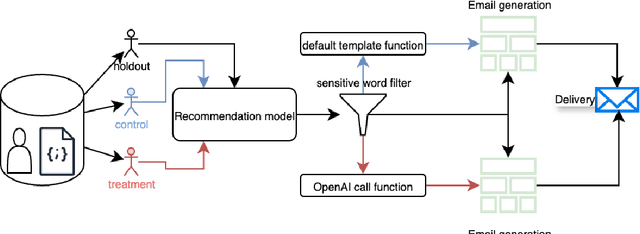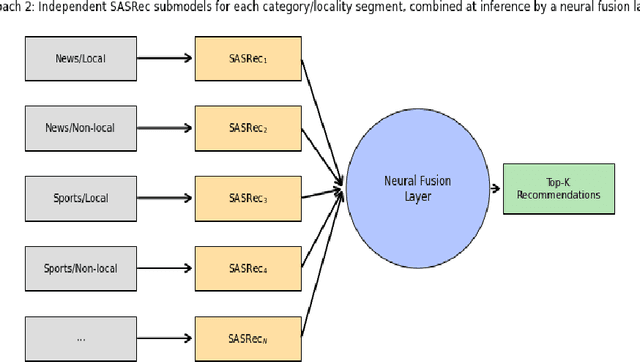Recommendation
Recommendation is the task of providing personalized suggestions to users based on their preferences and behavior.
Papers and Code
Efficient Large-Scale Cross-Domain Sequential Recommendation with Dynamic State Representations
Aug 28, 2025Recently, autoregressive recommendation models (ARMs), such as Meta's HSTU model, have emerged as a major breakthrough over traditional Deep Learning Recommendation Models (DLRMs), exhibiting the highly sought-after scaling law behaviour. However, when applied to multi-domain scenarios, the transformer architecture's attention maps become a computational bottleneck, as they attend to all items across every domain. To tackle this challenge, systems must efficiently balance inter and intra-domain knowledge transfer. In this work, we introduce a novel approach for scalable multi-domain recommendation systems by replacing full inter-domain attention with two innovative mechanisms: 1) Transition-Aware Positional Embeddings (TAPE): We propose novel positional embeddings that account for domain-transition specific information. This allows attention to be focused solely on intra-domain items, effectively reducing the unnecessary computational cost associated with attending to irrelevant domains. 2) Dynamic Domain State Representation (DDSR): We introduce a dynamic state representation for each domain, which is stored and accessed during subsequent token predictions. This enables the efficient transfer of relevant domain information without relying on full attention maps. Our method offers a scalable solution to the challenges posed by large-scale, multi-domain recommendation systems and demonstrates significant improvements in retrieval tasks by separately modelling and combining inter- and intra-domain representations.
Using item recommendations and LLMs in marketing email titles
Aug 27, 2025



E-commerce marketplaces make use of a number of marketing channels like emails, push notifications, etc. to reach their users and stimulate purchases. Personalized emails especially are a popular touch point for marketers to inform users of latest items in stock, especially for those who stopped visiting the marketplace. Such emails contain personalized recommendations tailored to each user's interests, enticing users to buy relevant items. A common limitation of these emails is that the primary entry point, the title of the email, tends to follow fixed templates, failing to inspire enough interest in the contents. In this work, we explore the potential of large language models (LLMs) for generating thematic titles that reflect the personalized content of the emails. We perform offline simulations and conduct online experiments on the order of millions of users, finding our techniques useful in improving the engagement between customers and our emails. We highlight key findings and learnings as we productionize the safe and automated generation of email titles for millions of users.
A Model-agnostic Strategy to Mitigate Embedding Degradation in Personalized Federated Recommendation
Aug 27, 2025Centralized recommender systems encounter privacy leakage due to the need to collect user behavior and other private data. Hence, federated recommender systems (FedRec) have become a promising approach with an aggregated global model on the server. However, this distributed training paradigm suffers from embedding degradation caused by suboptimal personalization and dimensional collapse, due to the existence of sparse interactions and heterogeneous preferences. To this end, we propose a novel model-agnostic strategy for FedRec to strengthen the personalized embedding utility, which is called Personalized Local-Global Collaboration (PLGC). It is the first research in federated recommendation to alleviate the dimensional collapse issue. Particularly, we incorporate the frozen global item embedding table into local devices. Based on a Neural Tangent Kernel strategy that dynamically balances local and global information, PLGC optimizes personalized representations during forward inference, ultimately converging to user-specific preferences. Additionally, PLGC carries on a contrastive objective function to reduce embedding redundancy by dissolving dependencies between dimensions, thereby improving the backward representation learning process. We introduce PLGC as a model-agnostic personalized training strategy for federated recommendations that can be applied to existing baselines to alleviate embedding degradation. Extensive experiments on five real-world datasets have demonstrated the effectiveness and adaptability of PLGC, which outperforms various baseline algorithms.
A Hybrid Recommendation Framework for Enhancing User Engagement in Local News
Aug 27, 2025



Local news organizations face an urgent need to boost reader engagement amid declining circulation and competition from global media. Personalized news recommender systems offer a promising solution by tailoring content to user interests. Yet, conventional approaches often emphasize general preferences and may overlook nuanced or eclectic interests in local news. We propose a hybrid news recommender that integrates local and global preference models to improve engagement. Building on evidence of the value of localized models, our method unifies local and non-local predictors in one framework. The system adaptively combines recommendations from a local model, specialized in region-specific content, and a global model that captures broader preferences. Ensemble strategies and multiphase training balance the two. We evaluated the model on two datasets: a synthetic set based on Syracuse newspaper distributions and a Danish dataset (EB-NeRD) labeled for local and non-local content with an LLM. Results show our integrated approach outperforms single-model baselines in accuracy and coverage, suggesting improved personalization that can drive user engagement. The findings have practical implications for publishers, especially local outlets. By leveraging both community-specific and general user interests, the hybrid recommender can deliver more relevant content, increasing retention and subscriptions. In sum, this work introduces a new direction for recommender systems, bridging local and global models to revitalize local news consumption through scalable, personalized user experiences.
A Scenario-Oriented Survey of Federated Recommender Systems: Techniques, Challenges, and Future Directions
Aug 27, 2025Extending recommender systems to federated learning (FL) frameworks to protect the privacy of users or platforms while making recommendations has recently gained widespread attention in academia. This is due to the natural coupling of recommender systems and federated learning architectures: the data originates from distributed clients (mostly mobile devices held by users), which are highly related to privacy. In a centralized recommender system (CenRec), the central server collects clients' data, trains the model, and provides the service. Whereas in federated recommender systems (FedRec), the step of data collecting is omitted, and the step of model training is offloaded to each client. The server only aggregates the model and other knowledge, thus avoiding client privacy leakage. Some surveys of federated recommender systems discuss and analyze related work from the perspective of designing FL systems. However, their utility drops by ignoring specific recommendation scenarios' unique characteristics and practical challenges. For example, the statistical heterogeneity issue in cross-domain FedRec originates from the label drift of the data held by different platforms, which is mainly caused by the recommender itself, but not the federated architecture. Therefore, it should focus more on solving specific problems in real-world recommendation scenarios to encourage the deployment FedRec. To this end, this review comprehensively analyzes the coupling of recommender systems and federated learning from the perspective of recommendation researchers and practitioners. We establish a clear link between recommendation scenarios and FL frameworks, systematically analyzing scenario-specific approaches, practical challenges, and potential opportunities. We aim to develop guidance for the real-world deployment of FedRec, bridging the gap between existing research and applications.
Improving Recommendation Fairness via Graph Structure and Representation Augmentation
Aug 27, 2025Graph Convolutional Networks (GCNs) have become increasingly popular in recommendation systems. However, recent studies have shown that GCN-based models will cause sensitive information to disseminate widely in the graph structure, amplifying data bias and raising fairness concerns. While various fairness methods have been proposed, most of them neglect the impact of biased data on representation learning, which results in limited fairness improvement. Moreover, some studies have focused on constructing fair and balanced data distributions through data augmentation, but these methods significantly reduce utility due to disruption of user preferences. In this paper, we aim to design a fair recommendation method from the perspective of data augmentation to improve fairness while preserving recommendation utility. To achieve fairness-aware data augmentation with minimal disruption to user preferences, we propose two prior hypotheses. The first hypothesis identifies sensitive interactions by comparing outcomes of performance-oriented and fairness-aware recommendations, while the second one focuses on detecting sensitive features by analyzing feature similarities between biased and debiased representations. Then, we propose a dual data augmentation framework for fair recommendation, which includes two data augmentation strategies to generate fair augmented graphs and feature representations. Furthermore, we introduce a debiasing learning method that minimizes the dependence between the learned representations and sensitive information to eliminate bias. Extensive experiments on two real-world datasets demonstrate the superiority of our proposed framework.
Skill-based Explanations for Serendipitous Course Recommendation
Aug 27, 2025Academic choice is crucial in U.S. undergraduate education, allowing students significant freedom in course selection. However, navigating the complex academic environment is challenging due to limited information, guidance, and an overwhelming number of choices, compounded by time restrictions and the high demand for popular courses. Although career counselors exist, their numbers are insufficient, and course recommendation systems, though personalized, often lack insight into student perceptions and explanations to assess course relevance. In this paper, a deep learning-based concept extraction model is developed to efficiently extract relevant concepts from course descriptions to improve the recommendation process. Using this model, the study examines the effects of skill-based explanations within a serendipitous recommendation framework, tested through the AskOski system at the University of California, Berkeley. The findings indicate that these explanations not only increase user interest, particularly in courses with high unexpectedness, but also bolster decision-making confidence. This underscores the importance of integrating skill-related data and explanations into educational recommendation systems.
Anomaly Detection in Networked Bandits
Aug 27, 2025The nodes' interconnections on a social network often reflect their dependencies and information-sharing behaviors. Nevertheless, abnormal nodes, which significantly deviate from most of the network concerning patterns or behaviors, can lead to grave consequences. Therefore, it is imperative to design efficient online learning algorithms that robustly learn users' preferences while simultaneously detecting anomalies. We introduce a novel bandit algorithm to address this problem. Through network knowledge, the method characterizes the users' preferences and residuals of feature information. By learning and analyzing these preferences and residuals, it develops a personalized recommendation strategy for each user and simultaneously detects anomalies. We rigorously prove an upper bound on the regret of the proposed algorithm and experimentally compare it with several state-of-the-art collaborative contextual bandit algorithms on both synthetic and real-world datasets.
The Double-edged Sword of LLM-based Data Reconstruction: Understanding and Mitigating Contextual Vulnerability in Word-level Differential Privacy Text Sanitization
Aug 26, 2025



Differentially private text sanitization refers to the process of privatizing texts under the framework of Differential Privacy (DP), providing provable privacy guarantees while also empirically defending against adversaries seeking to harm privacy. Despite their simplicity, DP text sanitization methods operating at the word level exhibit a number of shortcomings, among them the tendency to leave contextual clues from the original texts due to randomization during sanitization $\unicode{x2013}$ this we refer to as $\textit{contextual vulnerability}$. Given the powerful contextual understanding and inference capabilities of Large Language Models (LLMs), we explore to what extent LLMs can be leveraged to exploit the contextual vulnerability of DP-sanitized texts. We expand on previous work not only in the use of advanced LLMs, but also in testing a broader range of sanitization mechanisms at various privacy levels. Our experiments uncover a double-edged sword effect of LLM-based data reconstruction attacks on privacy and utility: while LLMs can indeed infer original semantics and sometimes degrade empirical privacy protections, they can also be used for good, to improve the quality and privacy of DP-sanitized texts. Based on our findings, we propose recommendations for using LLM data reconstruction as a post-processing step, serving to increase privacy protection by thinking adversarially.
APS Explorer: Navigating Algorithm Performance Spaces for Informed Dataset Selection
Aug 26, 2025Dataset selection is crucial for offline recommender system experiments, as mismatched data (e.g., sparse interaction scenarios require datasets with low user-item density) can lead to unreliable results. Yet, 86\% of ACM RecSys 2024 papers provide no justification for their dataset choices, with most relying on just four datasets: Amazon (38\%), MovieLens (34\%), Yelp (15\%), and Gowalla (12\%). While Algorithm Performance Spaces (APS) were proposed to guide dataset selection, their adoption has been limited due to the absence of an intuitive, interactive tool for APS exploration. Therefore, we introduce the APS Explorer, a web-based visualization tool for interactive APS exploration, enabling data-driven dataset selection. The APS Explorer provides three interactive features: (1) an interactive PCA plot showing dataset similarity via performance patterns, (2) a dynamic meta-feature table for dataset comparisons, and (3) a specialized visualization for pairwise algorithm performance.
 Add to Chrome
Add to Chrome Add to Firefox
Add to Firefox Add to Edge
Add to Edge